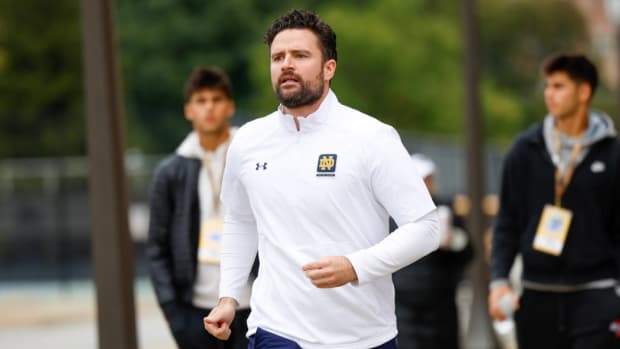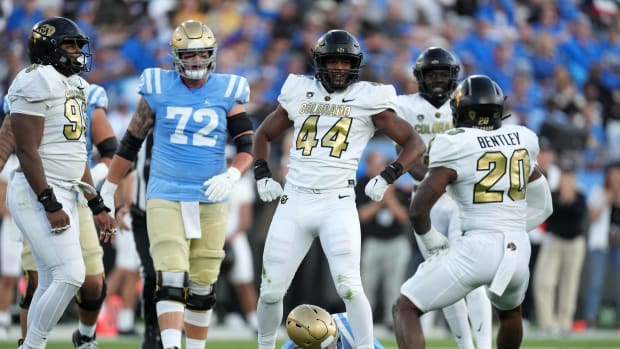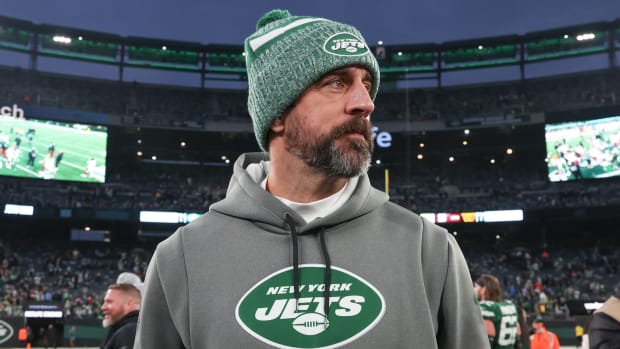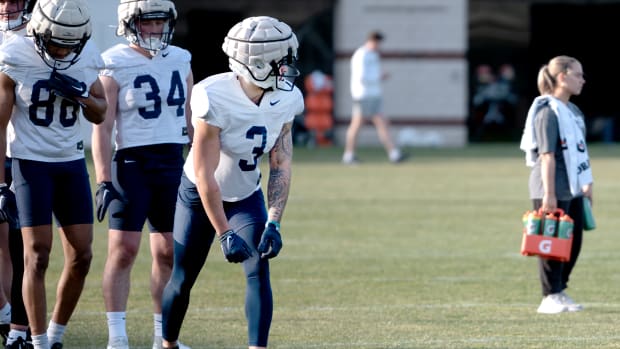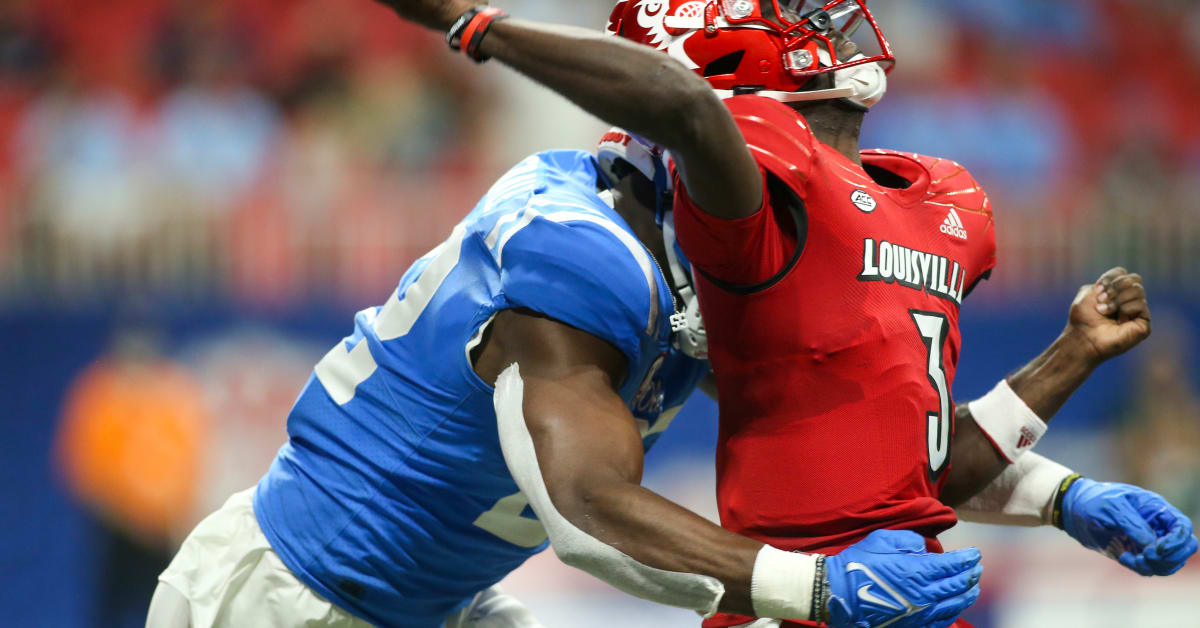
Targeting Not Going Away, and Neither Is the Debate and Criticism Around the Rule
Within a plush hotel ballroom in Indianapolis two days before the national championship game in January, Cincinnati coach Luke Fickell stood in front of more than 100 attendees at a ceremony in which he graciously accepted the Eddie Robinson Coach of the Year Award.
Before exiting the stage, the host asked him a single question: What is the one rule in the sport you would like to see changed?
Fickell did not hesitate: “We’ve got to stop ejecting players from college football.”
In college football, there is one foul that irks coaches, fans, broadcasters and others more than any other: targeting and the severe penalty that accompanies it. A player penalized for the foul is ejected from the current game and the opposing team gets 15 yards. If the player is penalized for it in the second half, he is out for the rest of the game and the first half of the subsequent game.

Many complaints around college football's targeting rule is what some perceive as an excessive punishment for a player who receives the penalty.
Brett Davis/USA Today Sports
While officials this offseason are exploring adjustments to the foul’s penalty, a study released this winter provides a chilling reminder of why the targeting foul exists in the first place: to reduce the risk of concussions. A four-year study conducted by the Pac-12 over conference and non-conference games from 2016 to ’19, shows the risk of concussions from targeting plays was 37 times higher than on non-targeting plays and 49 times higher when the targeting play was upheld. Fifteen players were concussed in 141 plays in which targeting was called—a 10.6% chance of concussion. In all other plays (68,529), players experienced 198 concussions (0.3% chance).
“This study would indicate that what we’re calling ‘targeting’ is the most dangerous plays we need to get out of the game,” says Steve Shaw, the NCAA’s national coordinator of officials. “This reaffirms that the targeting rule itself is the right rule. We’re working to take head hits out of the game.”
The study, published last month in the Orthopaedic Journal of Sports Medicine, further signals why officials will be hesitant to significantly change the rule.
“I hope this data is reviewed by those contemplating rule changes,” says Doug Aukerman, the associate athletic director at Oregon State who chairs the Pac-12’s medical advisory board and one of the sponsors of the study. “The penalty needs to be sufficient enough to discourage this kind of play. I don’t know that the current penalty format necessarily needs to stay the same as it is, but making this type of play illegal is important.”
The targeting rule was derived from the spearing penalty, which was defined by a player launching helmet-first into an opponent. The targeting penalty is more complicated now. There are two defined types of targeting with each featuring its own elements and penalties. There is targeting a “defenseless player,” which is often helmet-to-helmet contact with a quarterback in the pocket or a receiver catching a pass. It doesn’t always have to be the helmet. A forearm to the head of a defenseless player also meets the condition. The other is “forcible contact with the crown of the helmet,” which means leading with that crown of the helmet to any part of the body of an opposing player.
Competition and rules committee members are exploring a proposal this week that would limit the penalty to the game in which the player was assessed the foul if it is the player’s first targeting offense of the season. No matter when the targeting foul occurs in a game, the player would be suspended for the remainder of that game. However, in light of the study, which was presented to NCAA committees this week in Indianapolis during their annual rules meetings, the expectation is there will be no significant changes to the targeting foul or its penalty, officials tell Sports Illustrated.
“In the list of complaints about targeting, what I’ve not seen is an effective strategy of managing the same issue through different mechanisms,” SEC commissioner Greg Sankey told SI in January. “Relative to targeting itself, it is a well-intended rule that is difficult to enforce and creates controversy and consternation when it is enforced. I’ve seen enough research that it does change behavior.”
In the NFL, the penalty for targeting is at the discretion of commissioner Roger Goodell and normally results in a financial penalty, not disqualification. College football does not have the ability to fine players and, thus, “Playing time is a direct way to assess accountability,” Sankey says.
In data supplied to SI by Shaw, targeting fouls declined steeply during the back half of this past season. Overall in 2021, there were an average of 0.20 targeting fouls enforced per game, or one in every five games. That’s an improvement from ’20 (0.27), ’18 (0.26) and ’17 (0.23) and on par with ’19 (0.19). Last season, seven players in the FBS were flagged for targeting twice and one was flagged a third time in a bowl game.
The targeting penalty is one of many ways college sports leaders are combating concussions, the leading cause of injury in college football. According to the NCAA, concussions account for an average of 7.5% of injuries, which most commonly occur while blocking (20.4%) or tackling (19.9%). The NCAA, which implemented the targeting foul in 2008, added the ejection penalty in ’13, and somewhat relaxed the rule in ’19 when it required all elements of targeting to be present for the penalty to be confirmed during review. The rule, which has been widely criticized by coaches, players, fans and television broadcasters, drew its most substantial public criticism early this past season.
During a Labor Day game between Ole Miss and Louisville, four players were ejected, two from each team, for targeting fouls in the first half, leading Rebels coach Lane Kiffin to take a shot at officials during a halftime interview. Two weeks later, Auburn defender Zakoby McClain was ejected for targeting after his helmet smacked a ballcarrier’s helmet as he made a diving stop to potentially prevent a touchdown. McClain sounded off on Twitter a day later, suggesting maybe he should have let Penn State receiver Parker Washington score.
Some of the most vocal critics are those on the broadcasts who, in many ways, represent a large segment of fan bases everywhere. “Targeting makes me want to freaking scream!!!!!!!!!!!!!!!!!!!!!!!!” former Georgia star and current ESPN analyst David Pollack tweeted last fall.
Sankey says more education is needed for what the targeting rule is and why it exists.
“You’ll have commentators, where there is a clear targeting foul, who will spend five minutes of a broadcast diminishing the existence of the rule,” he says. “‘Well, he didn’t mean to do that! That’s just football.’ Well, no—the head and neck don’t understand accidental or intentional.”
Officials are in the midst of a holistic review of the football calendar, even if it rankles some who are entrenched in their beliefs and skeptical of emerging data. In the past five years alone, college sports have stripped the teeth from fall camp in the name of safety, eliminating two-a-days, cutting back practice days, adding mandatory off days and, most recently, abolishing long-standing collision drills. Officials recently decreased the number of full contact days of spring practice, as well.
NCAA committee members are also exploring changes that would shorten games, minimizing the amount of plays—and thus hits—in a single game. Some of those include continuing to run the clock after a first down and an incomplete pass. Many believe the moves are long shots to garner enough support to pass this year.
One proposed change that many believe has the support to pass: making all blocks below the waist outside of the tackle box illegal.
“Concussion rates are going down,” says Stefan Duma, a biomedical engineer and professor at Virginia Tech who has studied head injuries for years. “The NFL showed it last year. We have shown it in college. The helmet has a role to play, but the rules do as well. You see rates going down.
“When you follow the definition of targeting—launch and crown of the helmet—a suspension is warranted. In some of the cases where it is more accidental, they have room to interpret that if they want, but it has to be serious enough where players change their behavior.”
College executives fear any weakening of the targeting foul could fuel more litigation as well. The NCAA is facing more than 400 lawsuits from former college football players who claim their concussions were mistreated and led to medical problems. The first wave of lawsuits landed in 2016, and more than 200 have been filed since.
In 2010 the NCAA adopted legislation that funded studies on current prevention and return-to-play measures. Five years later, the Power 5 conferences passed concussion safety protocol legislation, requiring each of their 65 schools to adopt a policy for detecting concussions and return-to-play protocols.
“Football is barbaric, but it’s also the reason we love it,” says Ryan Cassidy, a former Rutgers football player who sits on NCAA governance committees as a college-athlete representative. “There is data proving how dangerous the game is. We’ve got to all be supportive of that data to put the game in the best position for the future.”
That said, Cassidy says there must be more “clarity” around the rule.
“Penalizing a player for a full game is tough,” he says. “How long is enough?”
It’s a question that continues to linger over the game.
More College Football Coverage:

